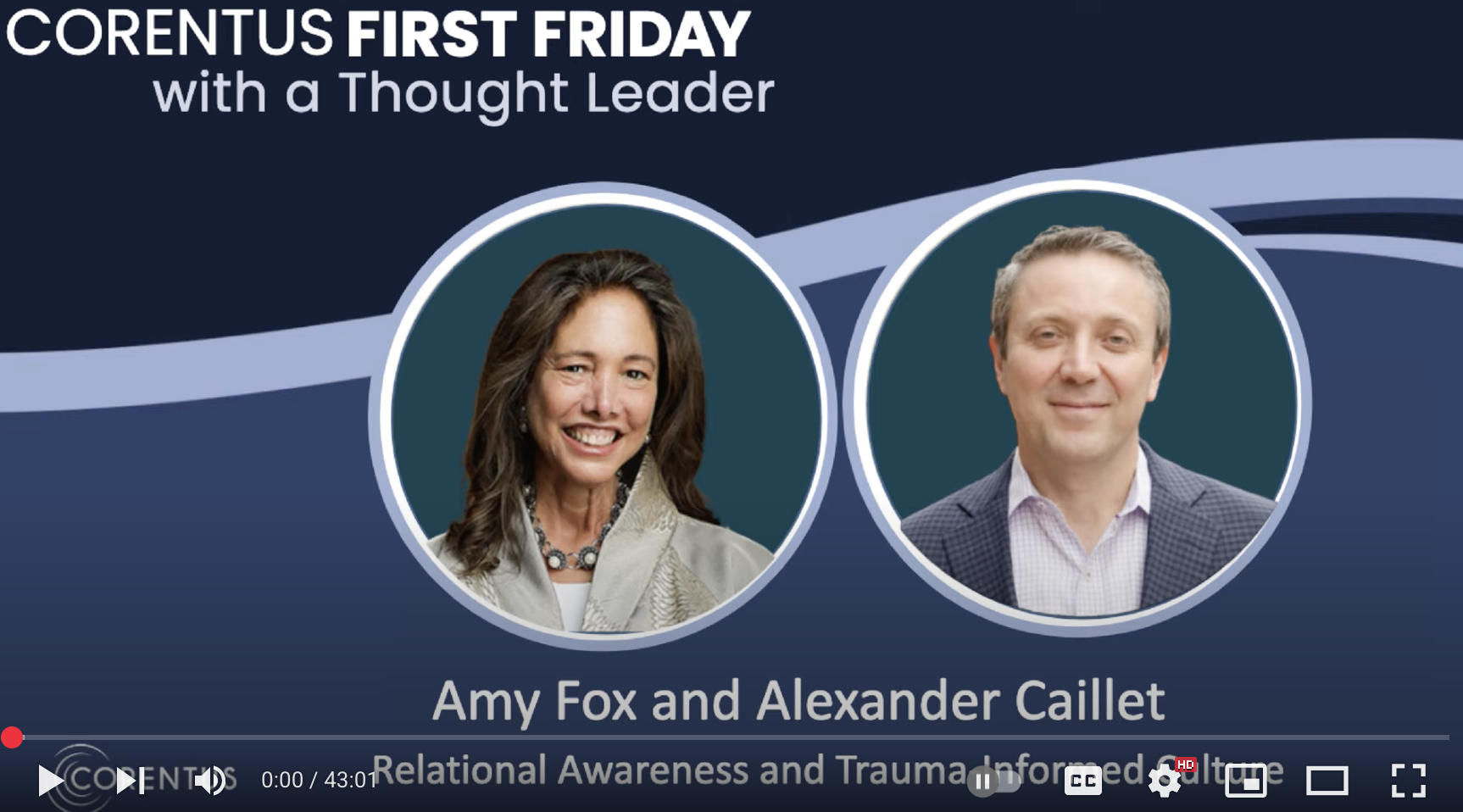Amy Elizabeth Fox & Alexander Caillet
Relational Awareness and Trauma-Informed Culture
Amy Elizabeth Fox and Alexander Caillet discuss what it truly means to be a trauma-informed organization—and why this is a critical for overall organizational success.
For you from Amy, Alex, & Corentus
From the First Friday with a Thought Leader event
Key Insights (below) & YouTube (43:01)
Amy Elizabeth Fox
A globally recognized leadership strategist and trauma-informed consultant, Amy has spent over two decades guiding Fortune 500 companies through deep culture transformation. As CEO of Mobius Executive Leadership, she integrates psycho-spiritual principles and trauma-informed practices into executive coaching and vertical development programs, helping leaders navigate complexity with agility and purpose.
Alexander Caillet
Co-founder of Corentus, Alexander is an internationally recognized organizational psychologist, consultant, and coach known for his pioneering work in team coaching and state-of-mind research. With over 30 years of experience across five continents, he has led organizational transformations, business turnarounds, and culture change initiatives for top executives and teams worldwide.
“ Relational Awareness and Trauma-Informed Culture ” (43:01)
KEY INSIGHTS | from our First Friday with a Thought Leader Event
Amy Elizabeth Fox & Alexander Caillet “Relational Awareness and Trauma-Informed Culture ”
Definition of Trauma: "Anything that, in the moment, the mind and the heart find overwhelming to prevent or an incident or a challenge that simply swamps the system's ability to metabolize the emotional.”
Lingering Effects: Traumatic experiences can lead to parts of ourselves getting "frozen in time," impacting our operating system until integrated and healed.
Decontextualization: Trauma, when decontextualized over time, can be mistaken for personality traits in individuals, family characteristics, or ingrained behaviors within a person.
Neurological Risk: Trauma triggers survival responses (fight, flight, freeze) by shutting down the neocortex and cognitive processing, leading to reactive and myopic behavior.
Long-Term Consequences: Survival strategies developed in response to past trauma can persist long after the threat has resolved, influencing default behavioral routines.
Increased Vulnerability: Individuals with a history of trauma are more susceptible to being overwhelmed and under-resourced during new challenges and collective stress.
The Need for a Trauma-Informed Lens
Reframing Derailers: Behaviors often labeled as "executive derailers" or "unexplained behaviors" may have roots in earlier survival strategies. A trauma-informed lens helps interpret these with compassion and reverence rather than judgment.
Understanding Team Dynamics: Fight, flight, or freeze responses manifest in team dynamics, hindering collaboration and psychological safety. Recognizing these as potential trauma responses is crucial for effective intervention.
Addressing Underlying Issues: Interventions need to address the underlying trauma and long-held emotions rather than just focusing on surface-level behaviors or cognitive shifts for sustainable change.
Creating Safety and Lowering Fear: Moving towards high performance and excellence requires lowering the level of fear and cultivating more love and caring within the organizational system.
Recognizing Immobilization: Lack of participation and withdrawal in teams can also be a symptom of threat and trauma, not just overt conflict.
The Role of Spirituality and the "Heart Cave"
Resources for Healing
Spirituality, expressive arts, and aesthetics can be powerful resources for organizational vitality, team dynamism, innovation, and deep healing.Three Chambers of the Heart (Shai Tubali)
Outer Layer: Responds to moment-by-moment life events.
Middle Layer
Holds historic hurts, fear, and terror, which can be activated by current challenges, leading to disproportionate reactions in trauma survivors.Innermost Chamber (Heart Cave)
The core self that cannot be hurt, connected to a unitive field and a sense of the divine. Tapping into this can be a source of strength and resilience.
Facilitator's Role: Facilitators need to attend to their own pain and shadow emotions to become a "wellspring of holding and harboring and witness to other people's" experiences. Deep listening has a co-regulatory capacity.
What it Means to Do Trauma-Informed Work
Becoming Trauma Literate
Understanding the literature on early childhood trauma, attachment, and developmental absences.Recognizing Regressive Dimensions
Understanding that individuals have a high-functioning adult dimension and a younger, less resourced regressive dimension that can be triggered by trauma. Practitioners need to be sensitive to this.Shifting Perspective
Moving from seeing "executive derailers" as weaknesses to understanding them as brilliant survival adaptations from earlier life.Compassion and Reverence
Approaching behaviors with compassion and reverence for the role they played in the individual's past.
Trauma-Informed Organizations and Leadership:
Safety and Threat
Focusing on the level of safety versus threat present within the system and the team's ability to discuss these openly.Addressing Symptoms at All Levels
Recognizing that trauma symptoms manifest at individual, dyadic, team, and organizational architecture levels.
Leadership in a Complex and Anxious World (BANI)
BANI Framework
Describing the current environment as Brittle, Anxious, Nonlinear, and Incomprehensible.Essential Leadership Qualities in a BANI World
Optionality and Fluidity: Ability to pivot easily when systems fail.Soothing and Self-Awareness
Leaders who can manage their own anxiety and soothe others.Collective Mindfulness and Groundedness
Practices for resilience in the face of anxiety.Intuitive Skills and Imagination
Tapping into collective intuition and co-creating the future.Dancing with Mystery and Soulfulness
Connecting to something wider, transcendental, and transpersonal through practices of devotion, prayer, and activism.
Vertical Development
Moving Beyond Cognitive Behavioral Approaches
Recognizing that simply changing behaviors or mental models is often short-lived.Addressing Core Fears and Unmet Needs
Sustainable change requires going deeper to explore long-held emotions, fundamental root fears, and unprocessed grief.Healing the Heart
Vertical development at this level is about healing and addressing the root causes of behavior.
"So being trauma sensitive means I bring not only compassion, but reverence for what otherwise I might judge if I'm not trauma-informed"
- Amy Elizabeth Fox
First Friday with a Thought Leader is a monthly live event for the Corentus Community of Professionals Advancing Team Effectiveness.
Interested in being a member of this professional community and/or receiving our monthly enewsletter? Let us know:
Vertical Development
Moving Beyond Cognitive Behavioral Approaches
Recognizing that simply changing behaviors or mental models is often short-lived.Addressing Core Fears and Unmet Needs
Sustainable change requires going deeper to explore long-held emotions, fundamental root fears, and unprocessed grief.Healing the Heart
Vertical development at this level is about healing and addressing the root causes of behavior.
Boundaries for Non-Clinically Trained Coaches
Challenging the Therapist/Coach Dichotomy
Moving beyond the artificial separation of therapists focusing on the past and coaches on the future.Individual Discernment
Each coach needs to assess their capacity to hold a conversation and discern when a situation feels outside their ability to contain and engage with.Red Flags
Danger to self or others and active flashbacks may indicate the need for psychotherapeutic support.Importance of Empathy and Attunement
A coach's empathetic presence and attuned relational repertoire can be meaningfully healing, even with difficult stories.Supervision and Collaboration
The importance of supervision and collaboration with trauma-trained psychotherapists for guidance and support.
Pitching Trauma-Informed Coaching
Focus on Outcomes
Pitching in terms of desired business outcomes like high-performing teams, collective intelligence, innovation, psychological safety, and feedback-rich cultures.Identifying the "When"
Situations where traditional coaching has stalled, teams are stuck in conflict, or there's a lack of psychological safety can be opportune moments.Highlighting Deeper Work
Emphasizing that getting to the root of issues requires a deeper approach beyond behavioral changes.Transparency vs. Trojan Horse
Adapting the level of explicitness about the "trauma" aspect based on the buyer's understanding and openness.Importance of an Ally
Having at least one person within the company who understands and supports the trauma-informed approach is crucial for success.
Working with Organizational Trauma:
Parallel Healing
Addressing both deep psycho-spiritual healing and organizational repair when the organization itself has been a source of trauma.Collective Awareness and Ownership
The leadership needs to acknowledge what happened and take collective responsibility for the resolution.Creating Space for the Unspeakable
Ownership creates a fertile ground for previously unspoken truths to emerge.



